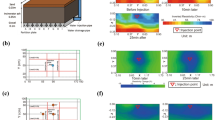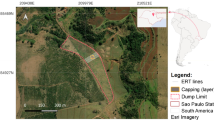Abstract
The grid-net electrical conductivity measurement system for detecting exact locations of landfill leachate intrusion in the subsurface was developed in this study. Laboratory and pilot-scale field model tests were performed to evaluate the direct application of a grid-net electrical conductivity measurement system for the detection of landfill leachate. A significant increase in electrical conductivity of soil was observed by adding landfill leachate. This can be explained as an increase in electrical conductivity of pore fluid due to an increase in leachate constituents as charge carriers. In pilot-scale field model tests, leachate intrusion locations were accurately identified at the initial stage of landfill leachate release by the grid-net electrical conductivity measurement system. The electrical conductivity of the subsurface before leachate injection lay within a small range of 24.8–43.0 μS/cm. The electrical conductivity values in detected points were approximately ten times more than the conductivity values of the subsurface without landfill leachate intrusion. The results in this study indicate that the grid-net electrical conductivity measurement method has a possible application for detecting locations of landfill leachate intrusion into the subsurface at the initial stage, and thus has great potential in monitoring leachate leakage at waste landfills.










Similar content being viewed by others
References
ASTM (1991) Standard test methods for electrical conductivity and resistivity of water, D1125–91. ASTM, Philadelphia
ASTM (2003) Test method for laboratory compaction characteristics of soil using standard effort, D698. ASTM, Philadelphia
Abu-Hassanein ZS, Benson CH, Blotz LR (1996) Electrical resistivity of compacted clays. J Geotech Eng 122(5):397–406
Bedient PB, Rifai HS, Newell CJ (1994) Groundwater contamination. Prentice Hall, Englewood Cliffs, 89 pp
Campanella RG, Weemees I (1990) Development and use of an electrical resistivity cone for groundwater contamination studies. Can Geotech J 27:557–567
Colucci P, Lavagnolo MC (1995) Three years field experience in electrical control of synthetic landfill liners. In: Proceedings of Sardinia 95, 5th International Landfill Symposium, 2 Oct–6 Oct 1995, Italy. Environmental Sanitary Engineering Centre, Cagliari, pp 437–452
Darilek GT, Corapcioglu MY, Yeung AT (1996) Sealing leaks in geomembrane liners using electrophoresis. J Environ Eng 122(6):540–544
Delaney AJ, Peapples PR, Arcone SA (2001) Electrical resistivity of frozen and petroleum-contaminated fine-grained soil. Cold Reg Sci Technol 32:107–119
Frangos W (1997) Electrical detection of leaks in lined waste disposal ponds. Geophysics 62(6):1737–1744
Fukue M, Minato T, Matsumoto M, Horibe H, Taya N (2001) Use of a resistivity cone for detecting contaminated soil layers. Eng Geol 60:361–369
Han JS (1998) Environment and contamination of groundwater (in Korean). Pakyoungsa, Seoul, Korea, 517 pp
Jackson P (1975) An electrical-resistivity method for evaluating the insitu porosity of clean marine sands. Mar Geotechnol 1(2):91–115
Kalinski RJ, Kelly WE (1994) Electrical-resistivity measurements for evaluating compacted-soil liners. J Geotech Eng 120(2):451–457
Kaya A, Fang HY (1997) Identification of contaminated soils by dielectric constant and electrical conductivity. J Environ Eng 123(2):169–177
Laine DL, Darilek GT (1993) Locating leaks in geomembrane liners of landfills covered with a protective soil. Geosynthetics '93, Vancouver, Canada, pp 1403–1412
Lindsay JB, Shang JQ, Rowe RK (2002) Using complex permittivity and artificial neural networks for contaminant prediction. J Environ Eng 128(8):740–747
Mccarter WJ (1984) The electrical resistivity characteristics of compacted clays. Geotechnique 34(2):263–267
Oh MH, Park JB (2000) Laboratory tests for the development of contaminant leakage detection system in soil. In: Proceedings of GeoEng 2000, International Conference on Geotechnical and Geological Engineering, 19–24 Nov 2000, Melbourne, Australia, Publication 2. Technomic Publishing Company, Pennsylvania, 286 pp
Oh MH, Park JB, Lee JH, Hong SW (2003) Development of contaminant leakage detection system using electrical resistivity measurement: evaluation of applicability for landfill site by field model. In: Proceedings of 12th Asia Regional Conference on Soil Mechanics and Geotechnical Engineering 4–8 Aug 2003, Singapore, World Scientific Publishing Co. Pte. Ltd, pp. 391–400
Okoye CN, Cotton TR, O'Meara D (1995) Application of resistivity cone penetration testing for qualitative delineation of creosote contamination in saturated soils. In: Proceedings of Geoenvironment 2000, Geotechnical Special Publication 46. ASCE, New York, pp 151–166
Park JB, Lee SH, Lee JW, Lee CY (2002) Lab scale experiments for permeable reactive barriers against contaminated groundwater with ammonium and heavy metals using clinoptilolite. J Hazard Mater B95:65–79
Parra JO (1988) Electrical response of a leak in a geomembrane liner. Geophysics 53(11):1445–1452
Parra JO, Owen TE (1988) Model studies of electrical leak detection surveys in geomembrane-lined impoundments. Geophysics 53(11):1453–1458
Rinaldi VA, Cuestas GA (2002) Ohmic conductivity of a compacted silty clay. J Geotech Geoenviron Eng 128(10):824–835
Yoon GL, Park JB (2001) Sensitivity of leachate and fine contents on electrical resistivity variations of sandy soil. J Hazard Mater B84:147–161
Yoon GL, Oh MH, Park JB (2002) Laboratory study of landfill leachate effect on resistivity in unsaturated soil using cone penetrometer. Environ Geol 43:18–28
Acknowledgement
This study was funded by the Korea Institute of Construction Technology and Ministry of Science & Technology, Korea.
Author information
Authors and Affiliations
Corresponding author
Rights and permissions
About this article
Cite this article
Oh, M.H., Lee, J.H., Yoon, G.L. et al. Pilot-scale field model tests for detecting landfill leachate intrusion into the subsurface using a grid-net electrical conductivity measurement system. Env Geol 45, 181–189 (2003). https://doi.org/10.1007/s00254-003-0880-4
Received:
Accepted:
Published:
Issue Date:
DOI: https://doi.org/10.1007/s00254-003-0880-4




